Experimental Study on the Effects of In Situ Stress on the Initiation and Propagation of Cracks during Hard Rock Blasting
Abstract
:Featured Application
Abstract
1. Introduction
2. Experiments
2.1. Experimental Apparatus
2.2. Specimen
2.3. Experimental Scheme
3. Experimental Results
3.1. Evolution of the Crack Network without Static Stress
3.2. Evolution of the Crack Network under an SSR of 0.1
3.3. Evolution of the Crack Network under an SSR of 0.15
3.4. Evolution of the Crack Network under an SSR of 0.2
3.5. Evolution of the Crack Network under an SSR of 0.3
3.6. Evolution of the Crack Network under an SSR of 0.4
4. Discussion
4.1. Effects of Static Stress on the Formation Time and the Type of Initial Crack
4.2. Effects of Static Stress on the Morphological Characteristics of the Crack Network
4.3. Relationship between the Strain Field Morphology and the Crack Network Morphology
4.4. Mechanism of the Uniaxial Static Stress Affecting Crack
5. Conclusions
- (1)
- Uniaxial static stress changes the type of initial cracks during rock blasting and leads to the delay of the initial cracks’ formation and propagation.
- (2)
- Under uniaxial static stress, circumferential cracks are prone to appear on both sides of the blast hole, perpendicular to the static stress and propagate along the static stress.
- (3)
- Under uniaxial static stress, the crack network during rock blasting is an ellipse with its long axis parallel to the static stress. The anisotropy of the crack network is positively correlated with the anisotropy of the static stress.
- (4)
- The strain field prior to crack appearance controls the initiation and propagation of cracks and determines the morphological characteristics of the crack network.
Author Contributions
Funding
Institutional Review Board Statement
Informed Consent Statement
Data Availability Statement
Acknowledgments
Conflicts of Interest
References
- Ranjith, P.; Zhao, J.; Ju, M.; de Silva, R.V.S.; Rathnaweera, T.; Bandara, A.K.M.S. Opportunities and challenges in deep mining: A brief review. Engineering 2017, 3, 546–551. [Google Scholar] [CrossRef]
- Fairhurst, C. Some challenges of deep mining. Engineering 2017, 3, 527–537. [Google Scholar] [CrossRef]
- Brown, E.T. Progress and challenges in some areas of deep mining. Min. Technol. 2012, 121, 177–191. [Google Scholar] [CrossRef]
- Qi, C.; Qian, Q.; Wang, M. Evolution of the deformation and fracturing in rock masses near deep-level tunnels. J. Min. Sci. 2009, 45, 112–119. [Google Scholar] [CrossRef]
- Kusui, A.; Villaescusa, E.; Funatsu, T. Mechanical behaviour of scaled-down unsupported tunnel walls in hard rock under high stress. Tunn. Undergr. Space Technol. 2016, 60, 30–40. [Google Scholar] [CrossRef]
- Onederra, I. A Fragmentation Model for Underground Production Blasting. Ph.D. Thesis, The University of Queensland, St Lucia Campus, Brisbane, Australia, 2005. [Google Scholar]
- An, L.; Suorineni, F.T.; Xu, S.; Li, Y.-H.; Wang, Z.-C. A feasibility study on confinement effect on blasting performance in narrow vein mining through numerical modelling. Int. J. Rock Mech. Min. Sci. 2018, 112, 84–94. [Google Scholar] [CrossRef]
- Fadillah, T. The rock fragmentation control in long hole blasting—Case study Antam Pongkor underground gold mine. IOP Conf. Ser. Earth Environ. Sci. 2018, 212, 012062. [Google Scholar] [CrossRef]
- Heidbach, O.; Tingay, M.; Barth, A.; Reinecker, J.; Kurfeß, D.; Müller, B. Global crustal stress pattern based on the World Stress Map database release 2008. Tectonophysics 2010, 482, 3–15. [Google Scholar] [CrossRef] [Green Version]
- Kang, H.; Zhang, X.; Si, L.; Wu, Y.; Gao, F. In-situ stress measurements and stress distribution characteristics in underground coal mines in China. Eng. Geol. 2010, 116, 333–345. [Google Scholar] [CrossRef]
- Gong, Q.; Yin, L.; Wu, S.; Zhao, J.; Ting, Y. Rock burst and slabbing failure and its influence on TBM excavation at headrace tunnels in Jinping II hydropower station. Eng. Geol. 2012, 124, 98–108. [Google Scholar] [CrossRef]
- Chen, B.-R.; Feng, X.-T.; Li, Q.-P.; Luo, R.-Z.; Li, S. Rock burst intensity classification based on the radiated energy with damage intensity at Jinping II hydropower station, China. Rock Mech. Rock Eng. 2015, 48, 289–303. [Google Scholar] [CrossRef]
- He, C.; Yang, J.; Yu, Q. Laboratory study on the dynamic response of rock under blast loading with active confining pressure. Int. J. Rock Mech. Min. Sci. 2018, 102, 101–108. [Google Scholar] [CrossRef]
- Rajmeny, P.; Singh, U.; Sinha, B. Predicting rock failure around boreholes and drives adjacent to stopes in Indian mines in high stress regions. Int. J. Rock Mech. Min. Sci. 2002, 39, 151–164. [Google Scholar] [CrossRef]
- Farhadian, H. A new empirical chart for rockburst analysis in tunnelling: Tunnel rockburst classification (TRC). Int. J. Rock Mech. Min. Sci. 2021, 31, 603–610. [Google Scholar] [CrossRef]
- Jiang, J.; Feng, X.-T.; Yang, C.; Su, G. Experimental study on the failure characteristics of granite subjected to weak dynamic disturbance under different σ3 conditions. Rock Mech. Rock Eng. 2021, 54, 5577–5590. [Google Scholar] [CrossRef]
- Wang, S.; Huang, L.; Li, X. Analysis of rockburst triggered by hard rock fragmentation using a conical pick under high uniaxial stress. Tunn. Undergr. Space Technol. 2020, 96, 103195. [Google Scholar] [CrossRef]
- Cai, M. Rock support in strainburst-prone ground. Int. J. Rock Mech. Min. Sci. 2019, 29, 529–534. [Google Scholar] [CrossRef]
- Donzé, F.V.; Bouchez, J.; Mangnier, S.A. Modeling fractures in rock blasting. Int. J. Rock Mech. Min. Sci. 1997, 34, 1153–1163. [Google Scholar] [CrossRef]
- Ma, G.W.; An, X.M. Numerical simulation of basting-induced rock fractures. Int. J. Rock Mech. Min. Sci. 2008, 45, 966–975. [Google Scholar] [CrossRef]
- Ping, Q.; Fang, Z.; Ma, D.; Zhang, H.; Stochino, F. Coupled static-dynamic tensile mechanical properties and energy dissipation characteristic of limestone specimen in SHPB tests. Adv. Civ. Eng. 2020, 2020, 7172928. [Google Scholar] [CrossRef] [Green Version]
- Zhou, Z.; Li, X.; Zou, Y.; Jiang, Y.; Li, G. Dynamic brazilian tests of granite under coupled static and dynamic loads. Rock Mech. Rock Eng. 2014, 47, 495–505. [Google Scholar] [CrossRef]
- Dehghanipoodeh, M.; Baghbanan, A.; Hashemolhosseini, H.; Laghaei, M.; Salimian, M. Investigating the deformability of grouted rock mass under static and dynamic loading conditions. Bull. Eng. Geol. Environ. 2019, 78, 4549–4566. [Google Scholar] [CrossRef]
- Zhang, F.; Yan, G.; Yang, Q.; Gao, J.; Li, Y. Strain field evolution characteristics of free surface during crater blasting in sandstone under high stress. Appl. Sci. 2020, 10, 6285. [Google Scholar] [CrossRef]
- Zhang, F.; Yan, G.; Peng, J.; Qiu, Z.; Dai, X. Experimental study on crack formation in sandstone during crater blasting under high geological stress. Bull. Eng. Geol. Environ. 2020, 79, 1323–1332. [Google Scholar] [CrossRef]
- Li, Y.; Peng, J.; Zhang, F.; Qiu, Z. Cracking behavior and mechanism of sandstone containing a pre-cut hole under combined static and dynamic loading. Eng. Geol. 2016, 213, 64–73. [Google Scholar] [CrossRef]
- Peng, J.; Li, Y.; Zhang, F.; Qiu, Z. Failure process and mechanism of sandstone under combined equal biaxial static compression and impact loading. Strain 2018, 54, e12267. [Google Scholar] [CrossRef]
- Yang, R.; Ding, C.; Li, Y.; Yang, L.; Zhao, Y. Crack propagation behavior in slit charge blasting under high static stress conditions. Int. J. Rock Mech. Min. Sci. 2019, 119, 117–123. [Google Scholar] [CrossRef]
- Yi, C.; Johansson, D.; Greberg, J. Effects of in-situ stresses on the fracturing of rock by blasting. Comput. Geotech. 2018, 104, 321–330. [Google Scholar] [CrossRef]
- Peng, J.; Zhang, F.; Du, C.; Yang, X. Effects of confining pressure on crater blasting in rock-like materials under electric explosion load. Int. J. Impact Eng. 2020, 139, 103534. [Google Scholar] [CrossRef]
- Liu, K.; Zhang, Q.B.; Wu, G.; Li, J.C.; Zhao, J. Dynamic mechanical and fracture behaviour of sandstone under multiaxial loads using a triaxial Hopkinson bar. Rock Mech. Rock Eng. 2019, 52, 2175–2195. [Google Scholar] [CrossRef]
- Xu, S.; Shan, J.; Zhang, L.; Zhou, L.; Gao, G.; Hu, S.; Wang, P. Dynamic compression behaviors of concrete under true triaxial confinement: An experimental technique. Mech. Mater. 2020, 140, 103220. [Google Scholar] [CrossRef]
- Wu, B.; Yao, W.; Xia, K. An experimental study of dynamic tensile failure of rocks subjected to hydrostatic confinement. Rock Mech. Rock Eng. 2016, 49, 3855–3864. [Google Scholar] [CrossRef]
- Kutter, H.; Fairhurst, C. On the fracture process in blasting. Int. J. Rock Mech. Min. Sci. Geomech. Abstr. 1971, 8, 181–202. [Google Scholar] [CrossRef]
- McHugh, S. Crack extension caused by internal gas pressure compared with extension caused by tensile stress. Int. J. Fract. 1983, 21, 163–176. [Google Scholar] [CrossRef]
- Cho, S.H.; Kaneko, K. Rock fragmentation control in blasting. Mater. Trans. 2004, 45, 1722–1730. [Google Scholar] [CrossRef] [Green Version]
- Li, D.; Xiao, P.; Han, Z.; Zhu, Q. Mechanical and failure properties of rocks with a cavity under coupled static and dynamic loads. Eng. Fract. Mech. 2020, 225, 1061958. [Google Scholar] [CrossRef]
- Zhao, J.-J.; Zhang, Y.; Ranjith, P. Numerical modelling of blast-induced fractures in coal masses under high in-situ stresses. Eng. Fract. Mech. 2020, 225, 10749. [Google Scholar] [CrossRef]
- Livingston, C. Fundamental concepts of rock failure. Q. Colo. Sch. Mines 1956, 51, 1–11. [Google Scholar]
- Yilmaz, O.; Unlu, T. Three dimensional numerical rock damage analysis under blasting load. Tunn. Undergr. Space Technol. 2013, 38, 266–278. [Google Scholar] [CrossRef]
- Peng, J.; Zhang, F.; Yan, G.; Qiu, Z.; Dai, X. Experimental study on rock-like materials fragmentation by electric explosion method under high stress condition. Powder Technol. 2019, 356, 750–758. [Google Scholar] [CrossRef]
- Peng, J.; Zhang, F.; Yang, X. Dynamic fracture and fragmentation of rock-like materials under column charge blasting using electrical explosion of wires. Powder Technol. 2020, 367, 517–526. [Google Scholar] [CrossRef]
- Bieniawski, Z.; Bernede, M. Suggested methods for determining the uniaxial compressive strength and deformability of rock materials: Part 1. Suggested method for determining deformability of rock materials in uniaxial compression. Int. J. Rock Mech. Min. Sci. Geomech. Abstr. 1979, 16, 138–140. [Google Scholar] [CrossRef]
- ISRM. Suggested Methods for Determining Tensile Strength of Rock Materials. Int. J. Rock Mech. Min. Sci. 1978, 15, 99–103. [Google Scholar] [CrossRef]
- Saiang, D.; Nordlund, E. Numerical analyses of the influence of blast-induced damaged rock around shallow tunnels in brittle rock. Rock Mech. Rock Eng. 2009, 42, 421–448. [Google Scholar] [CrossRef]
- Zhu, Z.; Mohanty, B.; Xie, H. Numerical investigation of blasting-induced crack initiation and propagation in rocks. Int. J. Rock Mech. Min. Sci. 2007, 44, 412–424. [Google Scholar] [CrossRef]
- Wesseloo, J.; Stacey, T.R. A reconsideration of the extension strain criterion for fracture and failure of rock. Rock Mech. Rock Eng. 2016, 49, 4667–4679. [Google Scholar] [CrossRef]
- Fujii, Y.; Kiyama, T.; Ishijima, Y.; Kodama, J. Examination of a rock failure criterion based on circumferential tensile strain. Pure Appl. Geophys. 1998, 152, 551–577. [Google Scholar] [CrossRef]
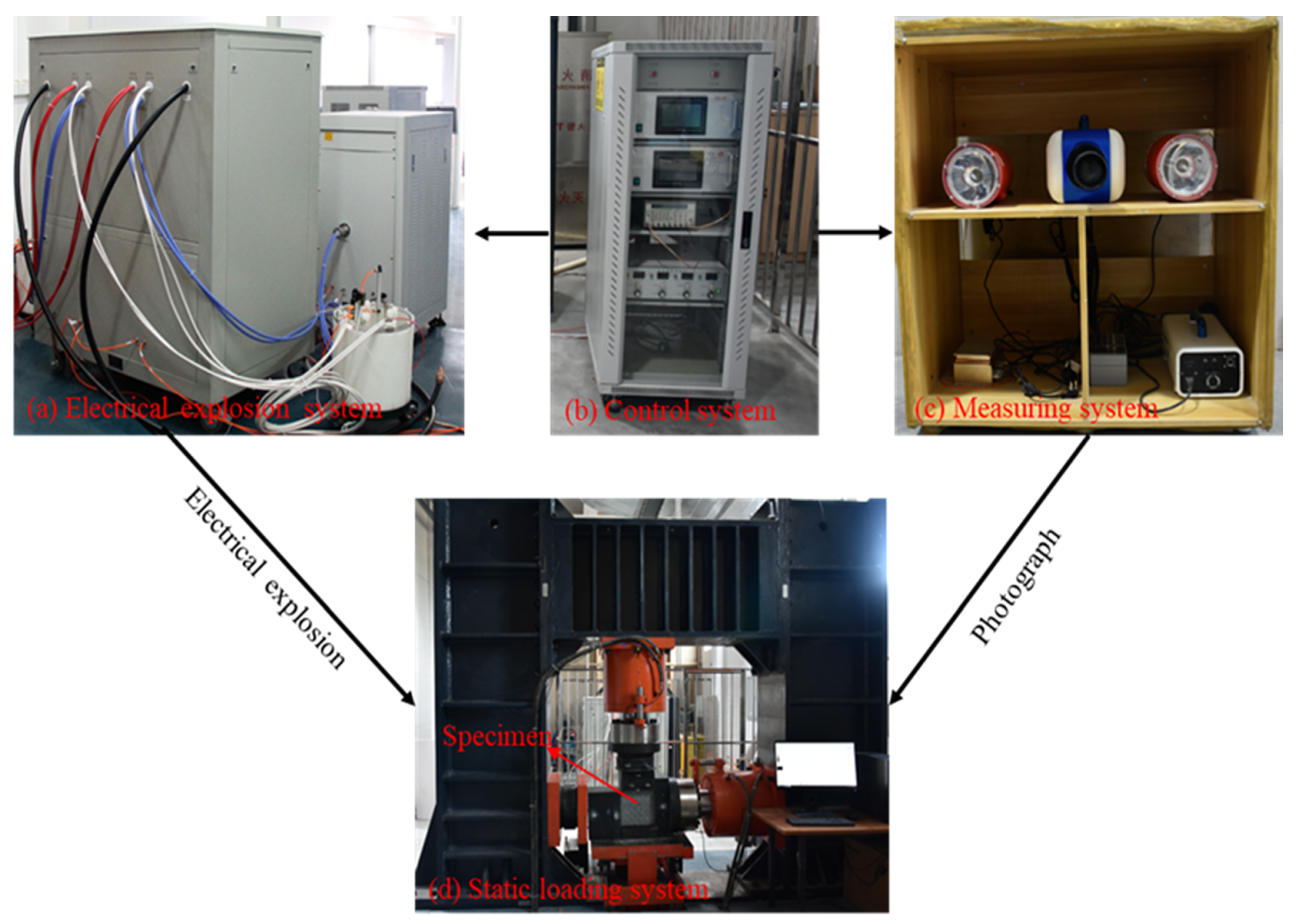
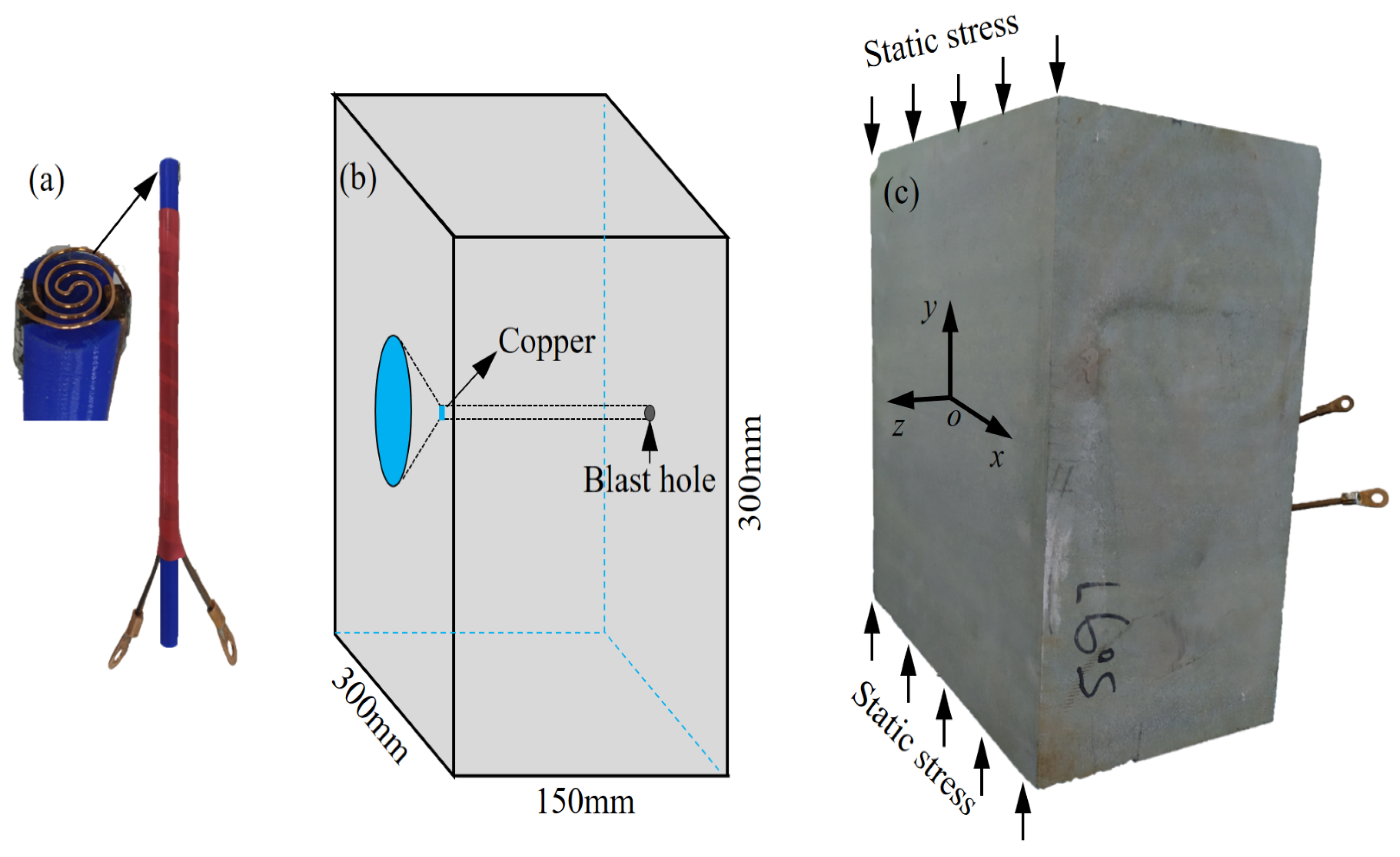

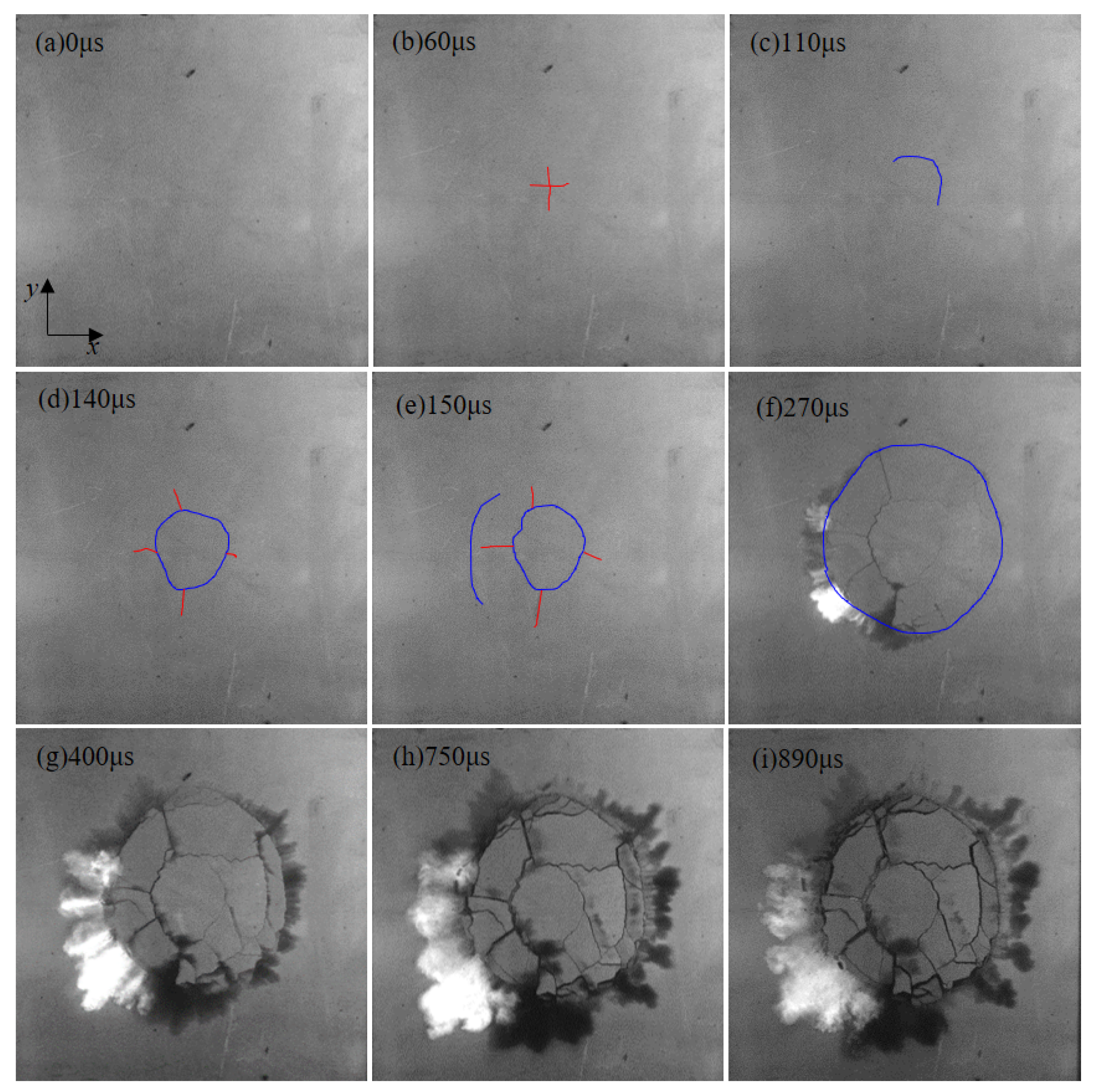
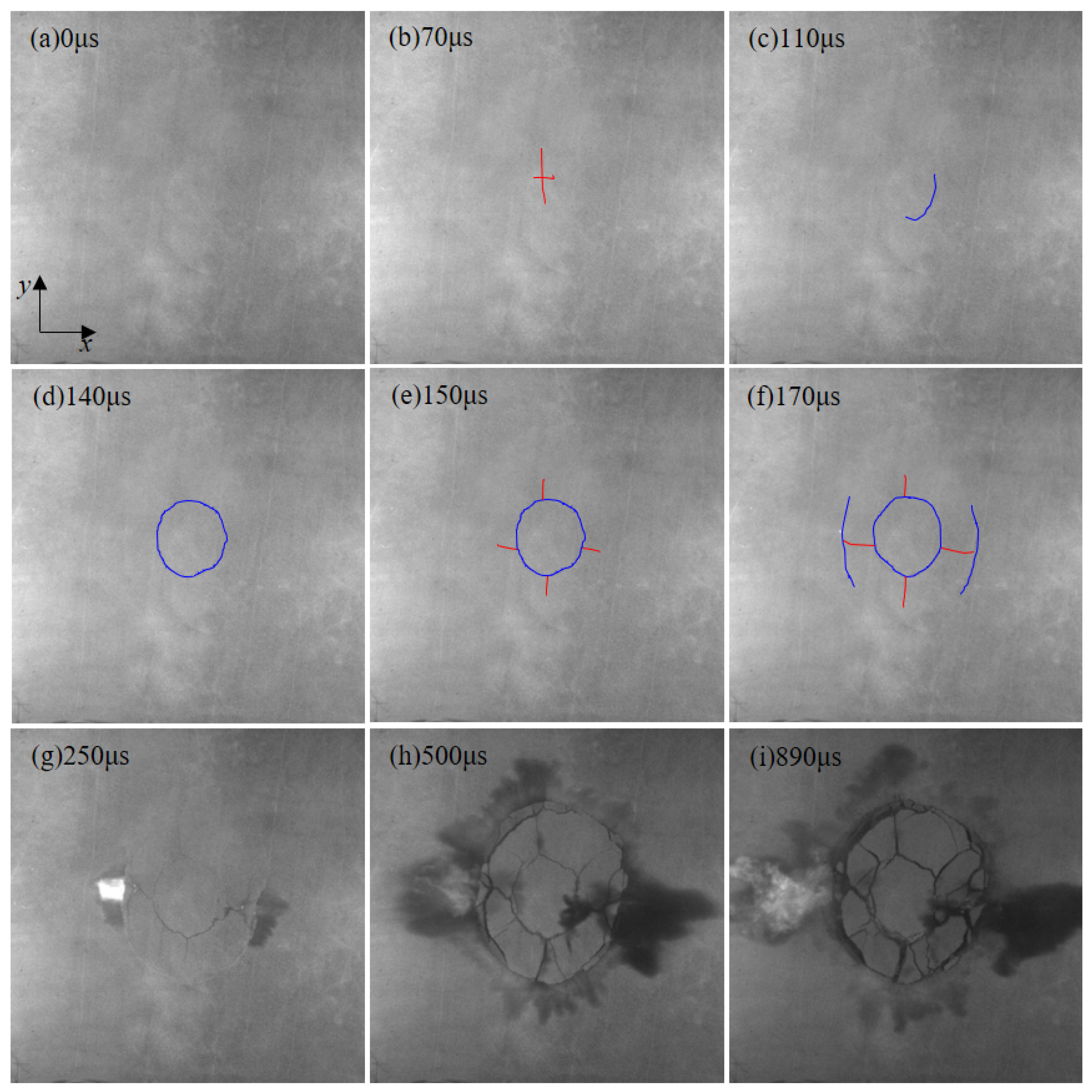
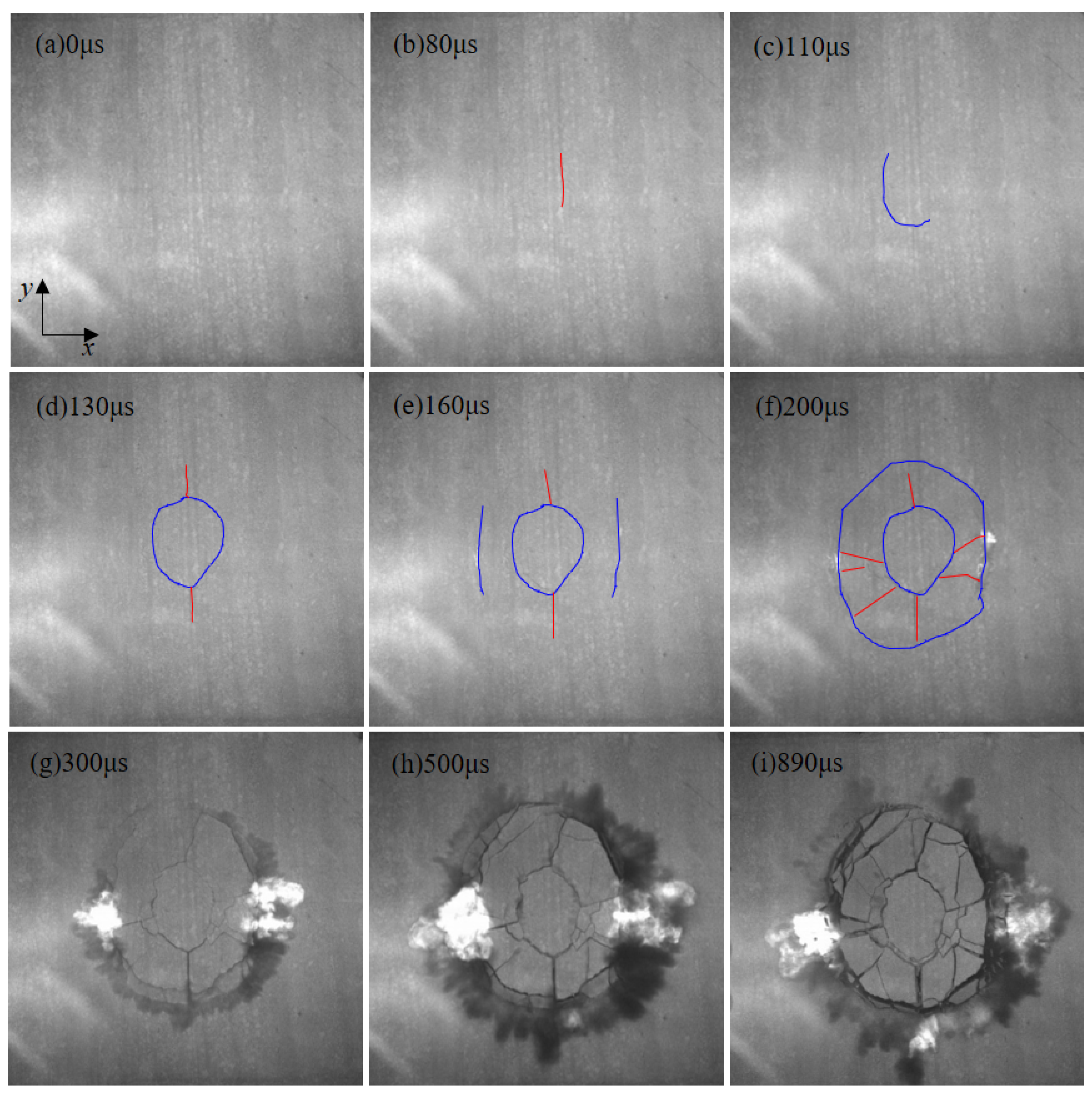
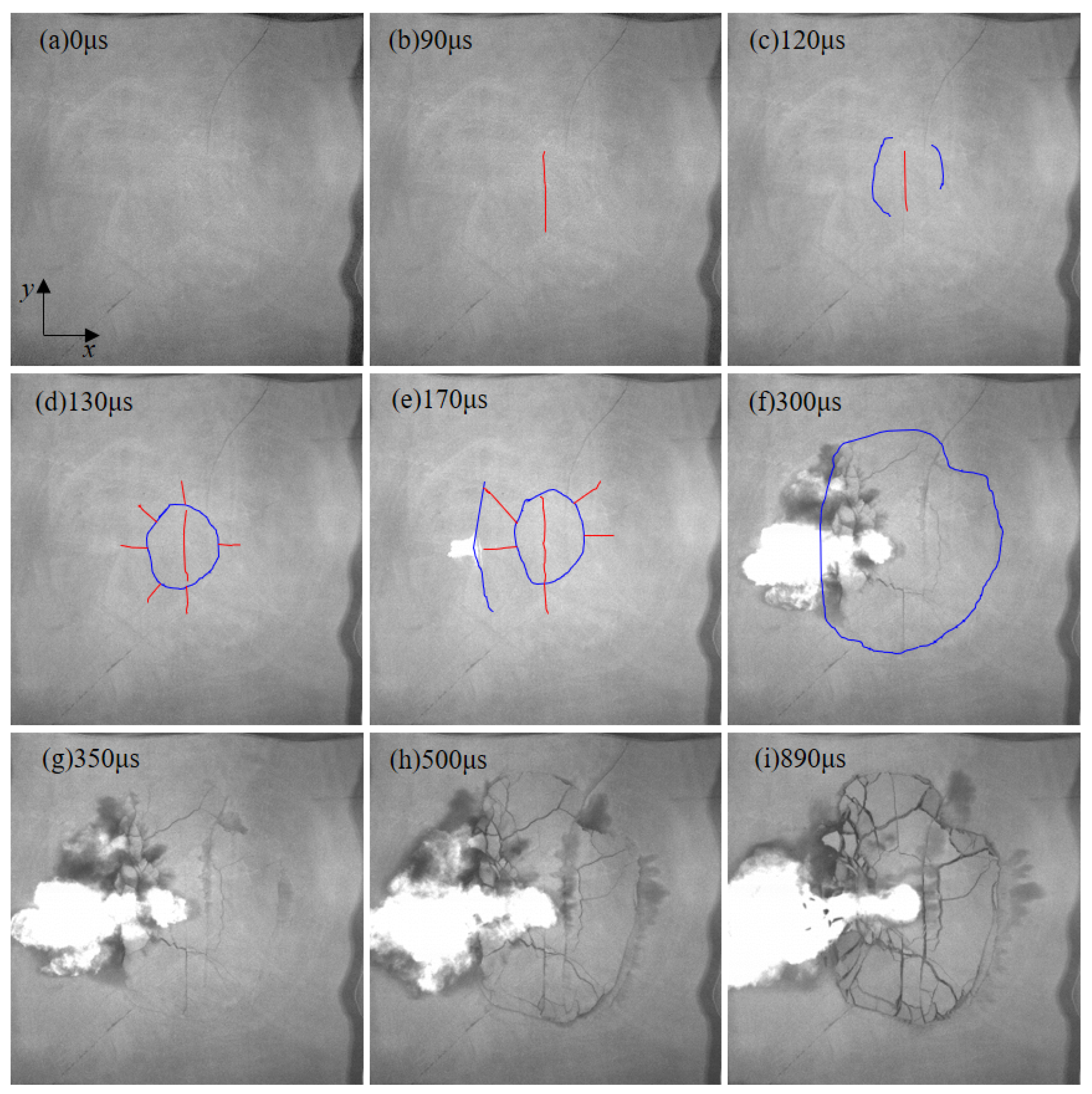

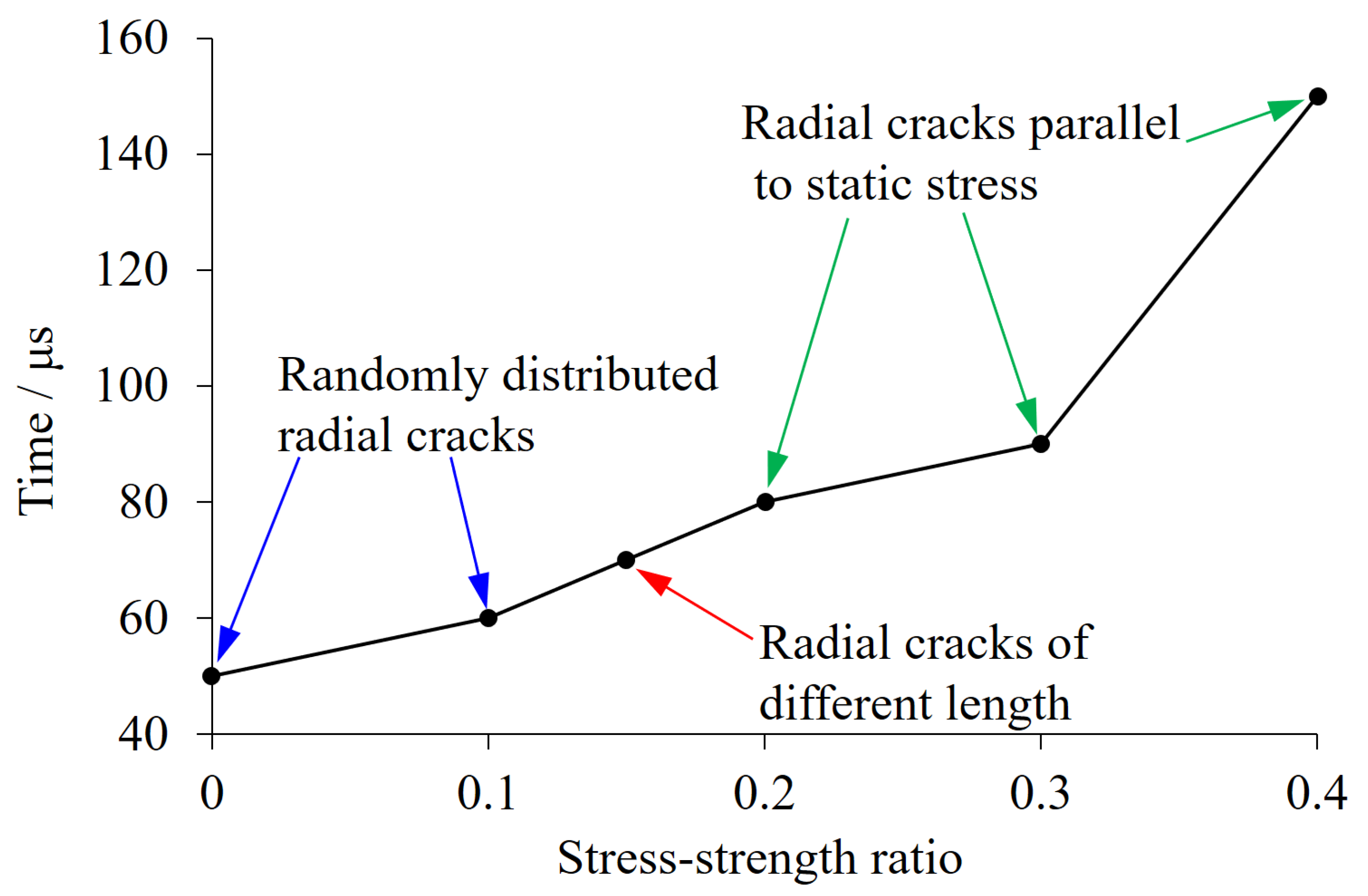
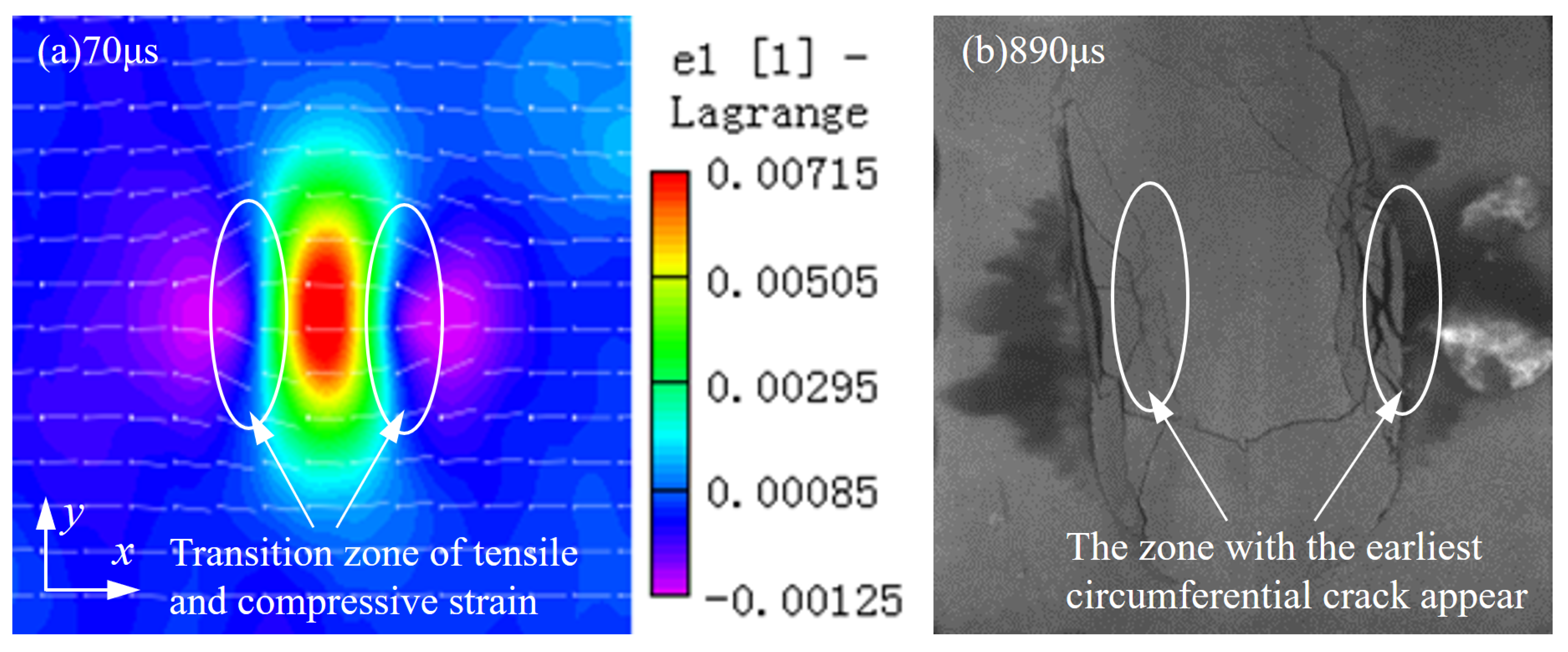
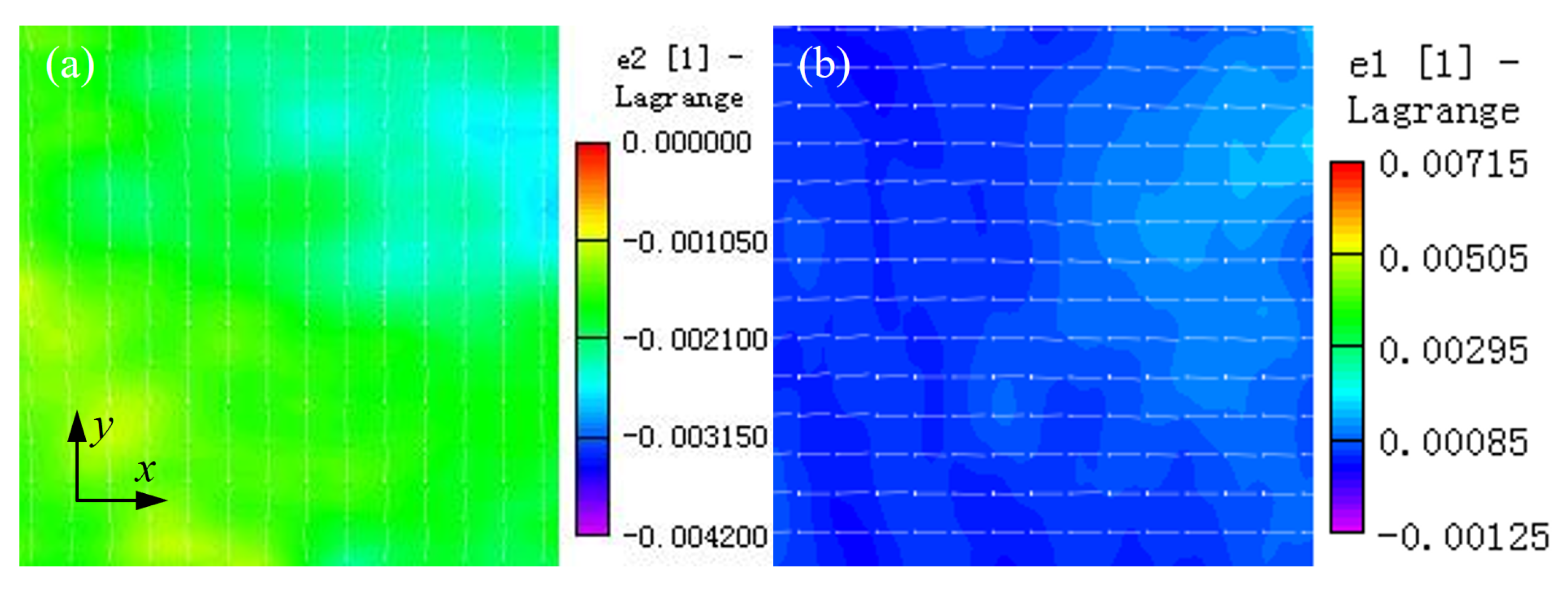
| Density kg/m3 | Young’s Modulus GPa | Poisson’s Ratio | Wave Velocity m/s | Compressive Strength MPa | Tensile Strength MPa |
|---|---|---|---|---|---|
| 2472 | 27.9 | 0.22 | 5028 | 80.7 | 4.2 |
| Specimen No | In Situ Stress MPa | SSR | Frequency Frame/s | Acquisition Time μs | Explosive Energy kJ |
|---|---|---|---|---|---|
| S1 | 0 | 0 | 200,000 | 895 | 5 |
| S2 | 8 | 0.1 | |||
| S3 | 12 | 0.15 | |||
| S4 | 16 | 0.2 | |||
| S5 | 24 | 0.3 | |||
| S6 | 32 | 0.4 |
Publisher’s Note: MDPI stays neutral with regard to jurisdictional claims in published maps and institutional affiliations. |
© 2021 by the authors. Licensee MDPI, Basel, Switzerland. This article is an open access article distributed under the terms and conditions of the Creative Commons Attribution (CC BY) license (https://creativecommons.org/licenses/by/4.0/).
Share and Cite
Yan, G.; Yang, Q.; Zhang, F.; Hao, Q.; Wang, X.; Wang, H. Experimental Study on the Effects of In Situ Stress on the Initiation and Propagation of Cracks during Hard Rock Blasting. Appl. Sci. 2021, 11, 11169. https://doi.org/10.3390/app112311169
Yan G, Yang Q, Zhang F, Hao Q, Wang X, Wang H. Experimental Study on the Effects of In Situ Stress on the Initiation and Propagation of Cracks during Hard Rock Blasting. Applied Sciences. 2021; 11(23):11169. https://doi.org/10.3390/app112311169
Chicago/Turabian StyleYan, Guangliang, Qibo Yang, Fengpeng Zhang, Qiqi Hao, Xiulong Wang, and Haonan Wang. 2021. "Experimental Study on the Effects of In Situ Stress on the Initiation and Propagation of Cracks during Hard Rock Blasting" Applied Sciences 11, no. 23: 11169. https://doi.org/10.3390/app112311169





